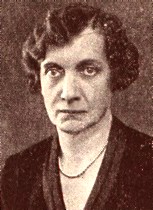Johanna Bordewijk-Roepman facts for kids
Johanna Bordewijk-Roepman (born August 4, 1892 – died October 8, 1971) was a talented Dutch composer. She was born in Rotterdam, a big city in the Netherlands. What's special about her is that she started writing music in 1917 without any formal lessons! She taught herself a lot.
Later, in 1937, she decided to learn more about how to write music for a whole orchestra. She studied with a conductor named Eduard Flipse. Johanna became very successful as a composer in the 1940s and 1950s.
In August 1914, she married Ferdinand Bordewijk, who was a famous writer. He even helped her by writing words for some of her musical pieces. They had two children, a son named Robert and a daughter named Nina. Johanna received an award in 1943 for one of her piano pieces called Piano Sonata. She passed away in The Hague.
Her Musical Journey
Johanna Bordewijk-Roepman's path in music was quite unique. She began composing without formal training, showing her natural talent. Her dedication led her to study orchestration, which is the art of arranging music for an orchestra. This helped her create larger and more complex pieces.
Her music became popular during the middle of the 20th century. She was known for her diverse works, from pieces for solo piano to grand orchestral compositions. Her collaboration with her husband, Ferdinand, also added a special touch to some of her vocal works.
Her Musical Creations
Johanna Bordewijk-Roepman wrote many different kinds of music. Here are some of her selected works:
- Variations II, op. 6 (1919): This was a piece for the piano.
- The Garden of Allah (1936): Music written for a full orchestra.
- Polish Suite (1937): Another piece for an orchestra.
- Sextet in C major (1938): This piece was for six wind instruments.
- Elog du Vent (1939): A song for a solo singer, a choir of women, and an orchestra.
- Piano Concerto in A-flat major (1940): A big piece for piano and orchestra.
- Les Illuminations (1940): Music for a singer and an orchestra.
- Roundabout (1941): This was an opera or operetta, which is like a play where people sing the story. Her husband wrote the story for it.
- Symphony (1942): A long and complex piece for a large orchestra.
- Sonata in E major (1943): Another piece for the piano.
- Epilogue (1943): A final piece for an orchestra.
- Mother of the Fatherland (1948): She wrote this special piece for the 50-year celebration of Queen Wilhelmina.
- Plato's death (1949): A big musical story for a narrator, singers, a choir, and a symphony orchestra.
- Praeludium and Fugue (1950): Music written for a carillon, which is a musical instrument made of many bells.
- The sacred circle (1950): A piece for a four-part choir.
- Triptych for carillon (1951): Another piece for the carillon.
- Roepman (1953): A song for a voice without any instruments.
- Reconstruction (1954): Music for a male choir singing without instruments.
- The moon (1961): A piece for a choir singing without instruments.


